Hongbo Zhao
VTCBench: Can Vision-Language Models Understand Long Context with Vision-Text Compression?
Dec 23, 2025Abstract:The computational and memory overheads associated with expanding the context window of LLMs severely limit their scalability. A noteworthy solution is vision-text compression (VTC), exemplified by frameworks like DeepSeek-OCR and Glyph, which convert long texts into dense 2D visual representations, thereby achieving token compression ratios of 3x-20x. However, the impact of this high information density on the core long-context capabilities of vision-language models (VLMs) remains under-investigated. To address this gap, we introduce the first benchmark for VTC and systematically assess the performance of VLMs across three long-context understanding settings: VTC-Retrieval, which evaluates the model's ability to retrieve and aggregate information; VTC-Reasoning, which requires models to infer latent associations to locate facts with minimal lexical overlap; and VTC-Memory, which measures comprehensive question answering within long-term dialogue memory. Furthermore, we establish the VTCBench-Wild to simulate diverse input scenarios.We comprehensively evaluate leading open-source and proprietary models on our benchmarks. The results indicate that, despite being able to decode textual information (e.g., OCR) well, most VLMs exhibit a surprisingly poor long-context understanding ability with VTC-processed information, failing to capture long associations or dependencies in the context.This study provides a deep understanding of VTC and serves as a foundation for designing more efficient and scalable VLMs.
MCITlib: Multimodal Continual Instruction Tuning Library and Benchmark
Aug 10, 2025Abstract:Continual learning aims to equip AI systems with the ability to continuously acquire and adapt to new knowledge without forgetting previously learned information, similar to human learning. While traditional continual learning methods focusing on unimodal tasks have achieved notable success, the emergence of Multimodal Large Language Models has brought increasing attention to Multimodal Continual Learning tasks involving multiple modalities, such as vision and language. In this setting, models are expected to not only mitigate catastrophic forgetting but also handle the challenges posed by cross-modal interactions and coordination. To facilitate research in this direction, we introduce MCITlib, a comprehensive and constantly evolving code library for continual instruction tuning of Multimodal Large Language Models. In MCITlib, we have currently implemented 8 representative algorithms for Multimodal Continual Instruction Tuning and systematically evaluated them on 2 carefully selected benchmarks. MCITlib will be continuously updated to reflect advances in the Multimodal Continual Learning field. The codebase is released at https://github.com/Ghy0501/MCITlib.
A Comprehensive Survey on Continual Learning in Generative Models
Jun 16, 2025Abstract:The rapid advancement of generative models has enabled modern AI systems to comprehend and produce highly sophisticated content, even achieving human-level performance in specific domains. However, these models remain fundamentally constrained by catastrophic forgetting - a persistent challenge where adapting to new tasks typically leads to significant degradation in performance on previously learned tasks. To address this practical limitation, numerous approaches have been proposed to enhance the adaptability and scalability of generative models in real-world applications. In this work, we present a comprehensive survey of continual learning methods for mainstream generative models, including large language models, multimodal large language models, vision language action models, and diffusion models. Drawing inspiration from the memory mechanisms of the human brain, we systematically categorize these approaches into three paradigms: architecture-based, regularization-based, and replay-based methods, while elucidating their underlying methodologies and motivations. We further analyze continual learning setups for different generative models, including training objectives, benchmarks, and core backbones, offering deeper insights into the field. The project page of this paper is available at https://github.com/Ghy0501/Awesome-Continual-Learning-in-Generative-Models.
MLLM-CL: Continual Learning for Multimodal Large Language Models
Jun 05, 2025



Abstract:Recent Multimodal Large Language Models (MLLMs) excel in vision-language understanding but face challenges in adapting to dynamic real-world scenarios that require continuous integration of new knowledge and skills. While continual learning (CL) offers a potential solution, existing benchmarks and methods suffer from critical limitations. In this paper, we introduce MLLM-CL, a novel benchmark encompassing domain and ability continual learning, where the former focuses on independently and identically distributed (IID) evaluation across evolving mainstream domains, whereas the latter evaluates on non-IID scenarios with emerging model ability. Methodologically, we propose preventing catastrophic interference through parameter isolation, along with an MLLM-based routing mechanism. Extensive experiments demonstrate that our approach can integrate domain-specific knowledge and functional abilities with minimal forgetting, significantly outperforming existing methods.
Restoring Real-World Images with an Internal Detail Enhancement Diffusion Model
May 24, 2025Abstract:Restoring real-world degraded images, such as old photographs or low-resolution images, presents a significant challenge due to the complex, mixed degradations they exhibit, such as scratches, color fading, and noise. Recent data-driven approaches have struggled with two main challenges: achieving high-fidelity restoration and providing object-level control over colorization. While diffusion models have shown promise in generating high-quality images with specific controls, they often fail to fully preserve image details during restoration. In this work, we propose an internal detail-preserving diffusion model for high-fidelity restoration of real-world degraded images. Our method utilizes a pre-trained Stable Diffusion model as a generative prior, eliminating the need to train a model from scratch. Central to our approach is the Internal Image Detail Enhancement (IIDE) technique, which directs the diffusion model to preserve essential structural and textural information while mitigating degradation effects. The process starts by mapping the input image into a latent space, where we inject the diffusion denoising process with degradation operations that simulate the effects of various degradation factors. Extensive experiments demonstrate that our method significantly outperforms state-of-the-art models in both qualitative assessments and perceptual quantitative evaluations. Additionally, our approach supports text-guided restoration, enabling object-level colorization control that mimics the expertise of professional photo editing.
A Birotation Solution for Relative Pose Problems
May 04, 2025Abstract:Relative pose estimation, a fundamental computer vision problem, has been extensively studied for decades. Existing methods either estimate and decompose the essential matrix or directly estimate the rotation and translation to obtain the solution. In this article, we break the mold by tackling this traditional problem with a novel birotation solution. We first introduce three basis transformations, each associated with a geometric metric to quantify the distance between the relative pose to be estimated and its corresponding basis transformation. Three energy functions, designed based on these metrics, are then minimized on the Riemannian manifold $\mathrm{SO(3)}$ by iteratively updating the two rotation matrices. The two rotation matrices and the basis transformation corresponding to the minimum energy are ultimately utilized to recover the relative pose. Extensive quantitative and qualitative evaluations across diverse relative pose estimation tasks demonstrate the superior performance of our proposed birotation solution. Source code, demo video, and datasets will be available at \href{https://mias.group/birotation-solution}{mias.group/birotation-solution} upon publication.
MRS: A Fast Sampler for Mean Reverting Diffusion based on ODE and SDE Solvers
Feb 11, 2025Abstract:In applications of diffusion models, controllable generation is of practical significance, but is also challenging. Current methods for controllable generation primarily focus on modifying the score function of diffusion models, while Mean Reverting (MR) Diffusion directly modifies the structure of the stochastic differential equation (SDE), making the incorporation of image conditions simpler and more natural. However, current training-free fast samplers are not directly applicable to MR Diffusion. And thus MR Diffusion requires hundreds of NFEs (number of function evaluations) to obtain high-quality samples. In this paper, we propose a new algorithm named MRS (MR Sampler) to reduce the sampling NFEs of MR Diffusion. We solve the reverse-time SDE and the probability flow ordinary differential equation (PF-ODE) associated with MR Diffusion, and derive semi-analytical solutions. The solutions consist of an analytical function and an integral parameterized by a neural network. Based on this solution, we can generate high-quality samples in fewer steps. Our approach does not require training and supports all mainstream parameterizations, including noise prediction, data prediction and velocity prediction. Extensive experiments demonstrate that MR Sampler maintains high sampling quality with a speedup of 10 to 20 times across ten different image restoration tasks. Our algorithm accelerates the sampling procedure of MR Diffusion, making it more practical in controllable generation.
Practical Continual Forgetting for Pre-trained Vision Models
Jan 16, 2025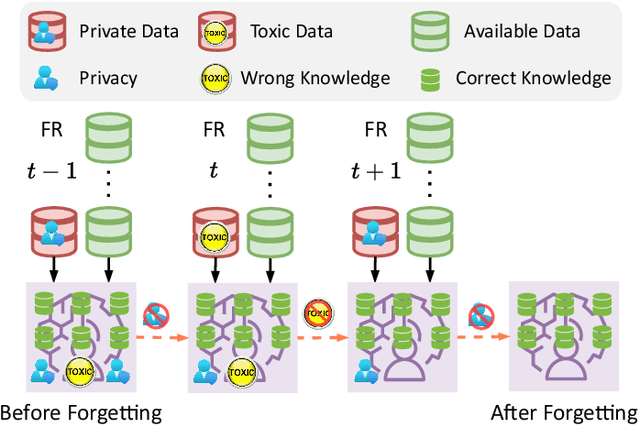

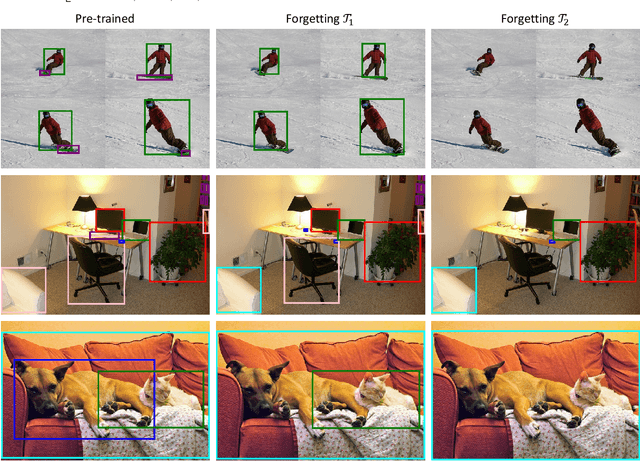
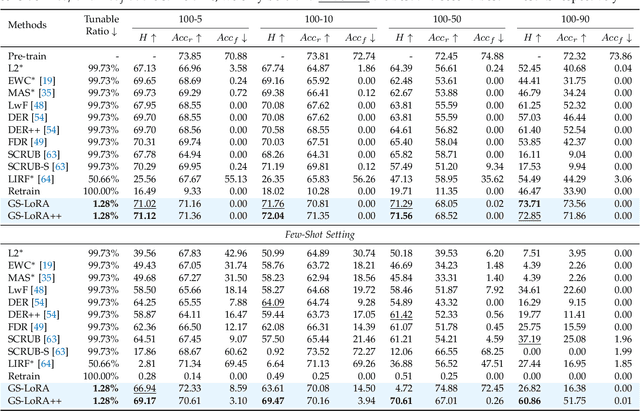
Abstract:For privacy and security concerns, the need to erase unwanted information from pre-trained vision models is becoming evident nowadays. In real-world scenarios, erasure requests originate at any time from both users and model owners, and these requests usually form a sequence. Therefore, under such a setting, selective information is expected to be continuously removed from a pre-trained model while maintaining the rest. We define this problem as continual forgetting and identify three key challenges. (i) For unwanted knowledge, efficient and effective deleting is crucial. (ii) For remaining knowledge, the impact brought by the forgetting procedure should be minimal. (iii) In real-world scenarios, the training samples may be scarce or partially missing during the process of forgetting. To address them, we first propose Group Sparse LoRA (GS-LoRA). Specifically, towards (i), we introduce LoRA modules to fine-tune the FFN layers in Transformer blocks for each forgetting task independently, and towards (ii), a simple group sparse regularization is adopted, enabling automatic selection of specific LoRA groups and zeroing out the others. To further extend GS-LoRA to more practical scenarios, we incorporate prototype information as additional supervision and introduce a more practical approach, GS-LoRA++. For each forgotten class, we move the logits away from its original prototype. For the remaining classes, we pull the logits closer to their respective prototypes. We conduct extensive experiments on face recognition, object detection and image classification and demonstrate that our method manages to forget specific classes with minimal impact on other classes. Codes have been released on https://github.com/bjzhb666/GS-LoRA.
OpenSatMap: A Fine-grained High-resolution Satellite Dataset for Large-scale Map Construction
Oct 30, 2024Abstract:In this paper, we propose OpenSatMap, a fine-grained, high-resolution satellite dataset for large-scale map construction. Map construction is one of the foundations of the transportation industry, such as navigation and autonomous driving. Extracting road structures from satellite images is an efficient way to construct large-scale maps. However, existing satellite datasets provide only coarse semantic-level labels with a relatively low resolution (up to level 19), impeding the advancement of this field. In contrast, the proposed OpenSatMap (1) has fine-grained instance-level annotations; (2) consists of high-resolution images (level 20); (3) is currently the largest one of its kind; (4) collects data with high diversity. Moreover, OpenSatMap covers and aligns with the popular nuScenes dataset and Argoverse 2 dataset to potentially advance autonomous driving technologies. By publishing and maintaining the dataset, we provide a high-quality benchmark for satellite-based map construction and downstream tasks like autonomous driving.
BACON: Bayesian Optimal Condensation Framework for Dataset Distillation
Jun 03, 2024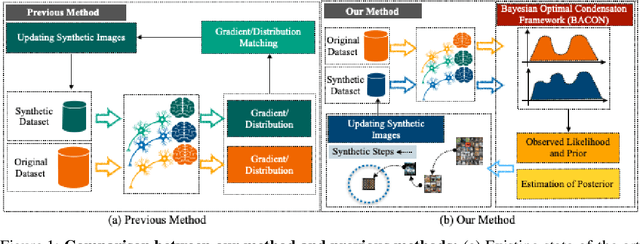
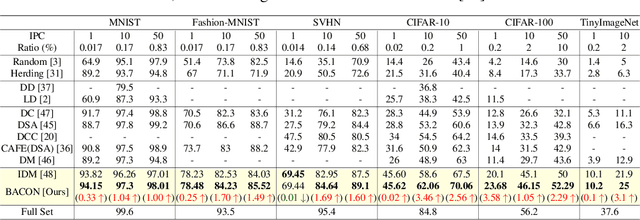
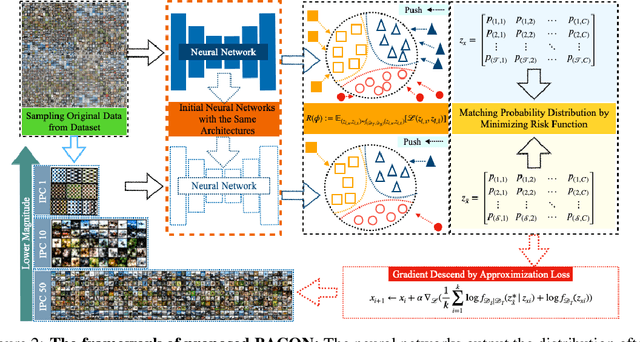
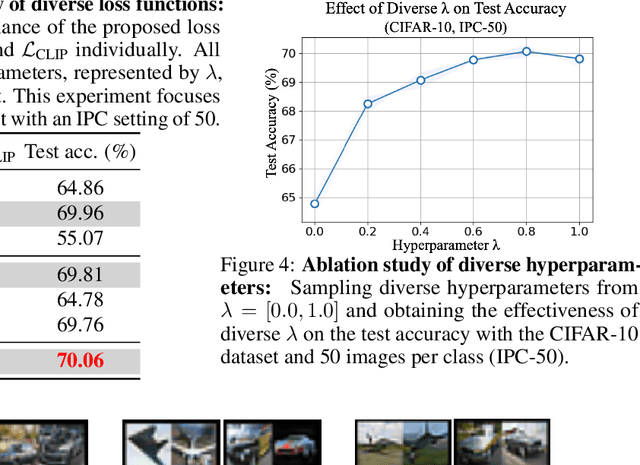
Abstract:Dataset Distillation (DD) aims to distill knowledge from extensive datasets into more compact ones while preserving performance on the test set, thereby reducing storage costs and training expenses. However, existing methods often suffer from computational intensity, particularly exhibiting suboptimal performance with large dataset sizes due to the lack of a robust theoretical framework for analyzing the DD problem. To address these challenges, we propose the BAyesian optimal CONdensation framework (BACON), which is the first work to introduce the Bayesian theoretical framework to the literature of DD. This framework provides theoretical support for enhancing the performance of DD. Furthermore, BACON formulates the DD problem as the minimization of the expected risk function in joint probability distributions using the Bayesian framework. Additionally, by analyzing the expected risk function for optimal condensation, we derive a numerically feasible lower bound based on specific assumptions, providing an approximate solution for BACON. We validate BACON across several datasets, demonstrating its superior performance compared to existing state-of-the-art methods. For instance, under the IPC-10 setting, BACON achieves a 3.46% accuracy gain over the IDM method on the CIFAR-10 dataset and a 3.10% gain on the TinyImageNet dataset. Our extensive experiments confirm the effectiveness of BACON and its seamless integration with existing methods, thereby enhancing their performance for the DD task. Code and distilled datasets are available at BACON.
 Add to Chrome
Add to Chrome Add to Firefox
Add to Firefox Add to Edge
Add to Edge